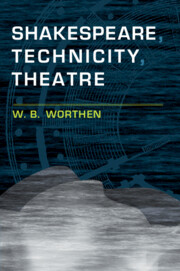Book contents
- Shakespeare, Technicity, Theatre
- Shakespeare, Technicity, Theatre
- Copyright page
- Contents
- Illustrations
- Acknowledgments
- Chapter 1 Introduction: Theatre, Medium, Technology
- Chapter 2 The Face, the Mask, the Screen: Acting and the Technologies of the Other
- Chapter 3 Shax the App
- Chapter 4 Interactive Remediation: Original Practices
- Chapter 5 Designing the Spectator
- Chapter 6 And Or And Not: Recoding Theatre
- Notes
- Works Cited
- Index
Chapter 1 - Introduction: Theatre, Medium, Technology
Published online by Cambridge University Press: 22 May 2020
- Shakespeare, Technicity, Theatre
- Shakespeare, Technicity, Theatre
- Copyright page
- Contents
- Illustrations
- Acknowledgments
- Chapter 1 Introduction: Theatre, Medium, Technology
- Chapter 2 The Face, the Mask, the Screen: Acting and the Technologies of the Other
- Chapter 3 Shax the App
- Chapter 4 Interactive Remediation: Original Practices
- Chapter 5 Designing the Spectator
- Chapter 6 And Or And Not: Recoding Theatre
- Notes
- Works Cited
- Index
Summary
Early on in her heavenly day, Winnie primps, recalling another, younger woman’s ambiguous immobility, as Romeo describes it, “Beauty’s ensign yet / Is crimson in thy lips and in thy cheeks, / And death’s pale flag is not advanced there” (5.3.94–6).1 Beckett’s lovers are hardly in Verona; they’re older, more jaded, staged in a blistering apocalyptic landscape. And Shakespeare’s language is no longer poetry, as it remains, perhaps, when Hamm quotes Prospero in Endgame (“Our revels now are ended” 120); it would take only a gesture from the actress – inspecting the lipstick tube – for “Ensign crimson” to register as advertising, the lingo of labels.2 Shakespeare and other poets appear throughout Beckett’s plays – “My kingdom for a nightman!” Hamm roars (Endgame 102) – and this texture of dramatic reference is part of Beckett’s long-recognized effort to mark the medium as the message: the “anguish of perceivedness” in Film (324), the endless repetition of a dramatic now in Waiting for Godot, the narrations that frame an exiguous presence in the radio plays.3 But this metadramatic impulse requires a technical armature, and Beckett’s works for stage, radio, television, and film locate the dramatic action within precise technological affordances. As Bernard Stiegler suggests, theatrical and recording technologies don’t serve merely to represent dramatic-action-as-knowledge; they are themselves “concretions of knowledge and abilities in objects and devices passed on as things belonging to the human world,” articulating a “mnemo-technical dimension” that bears “the memory of gestures and functions” across time (Symbolic Misery 1: 7).4
- Type
- Chapter
- Information
- Shakespeare, Technicity, Theatre , pp. 1 - 37Publisher: Cambridge University PressPrint publication year: 2020



